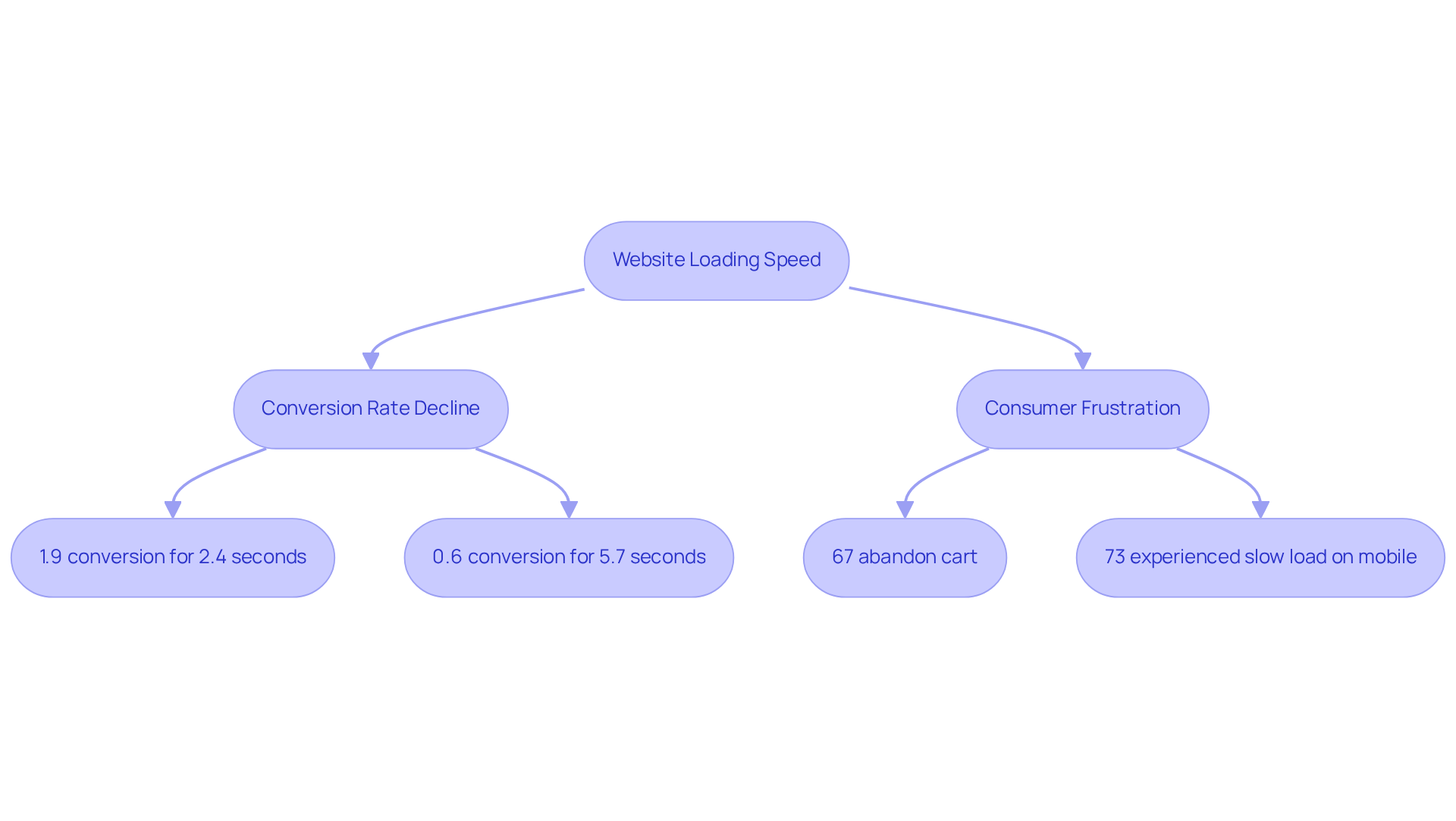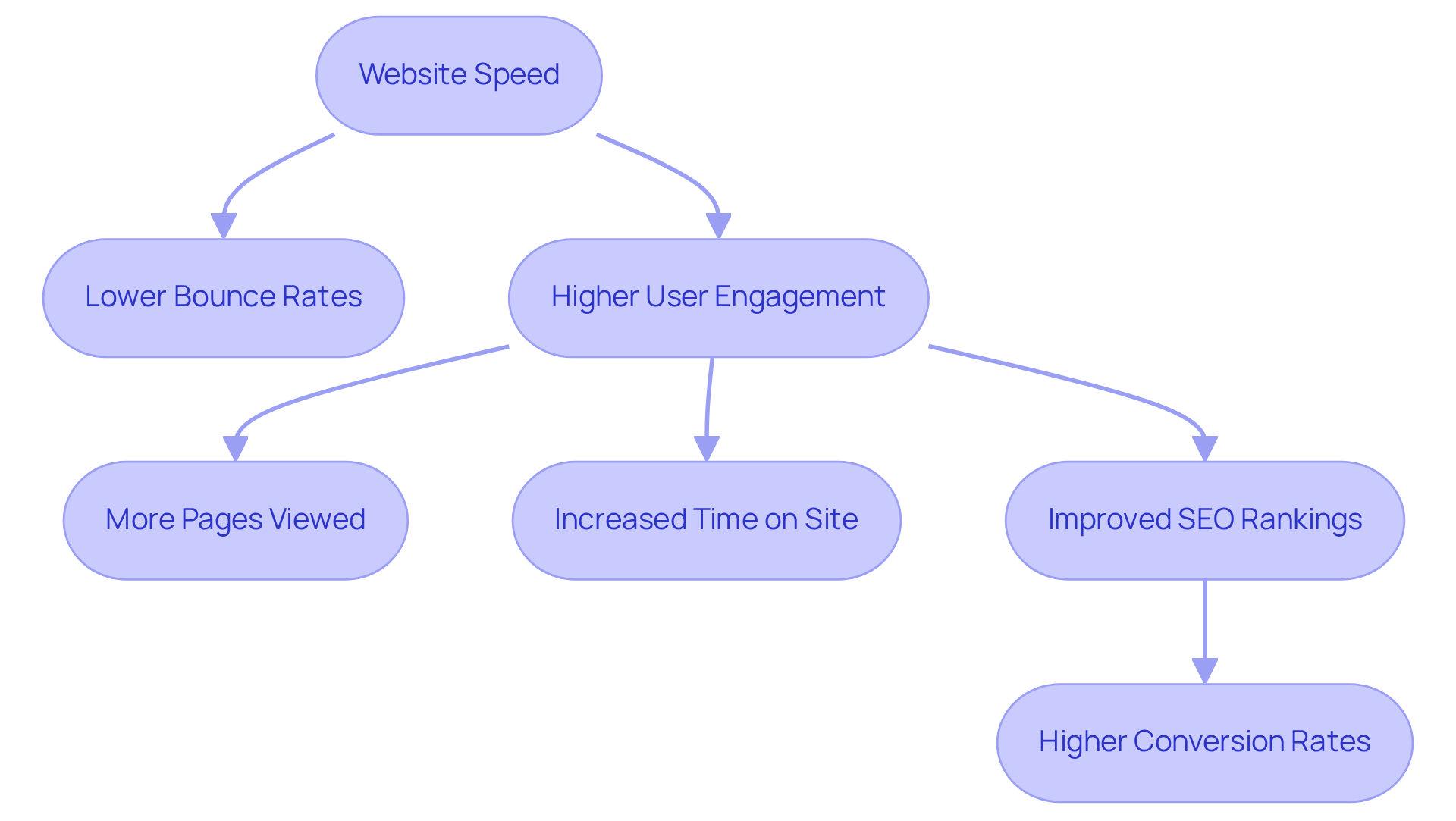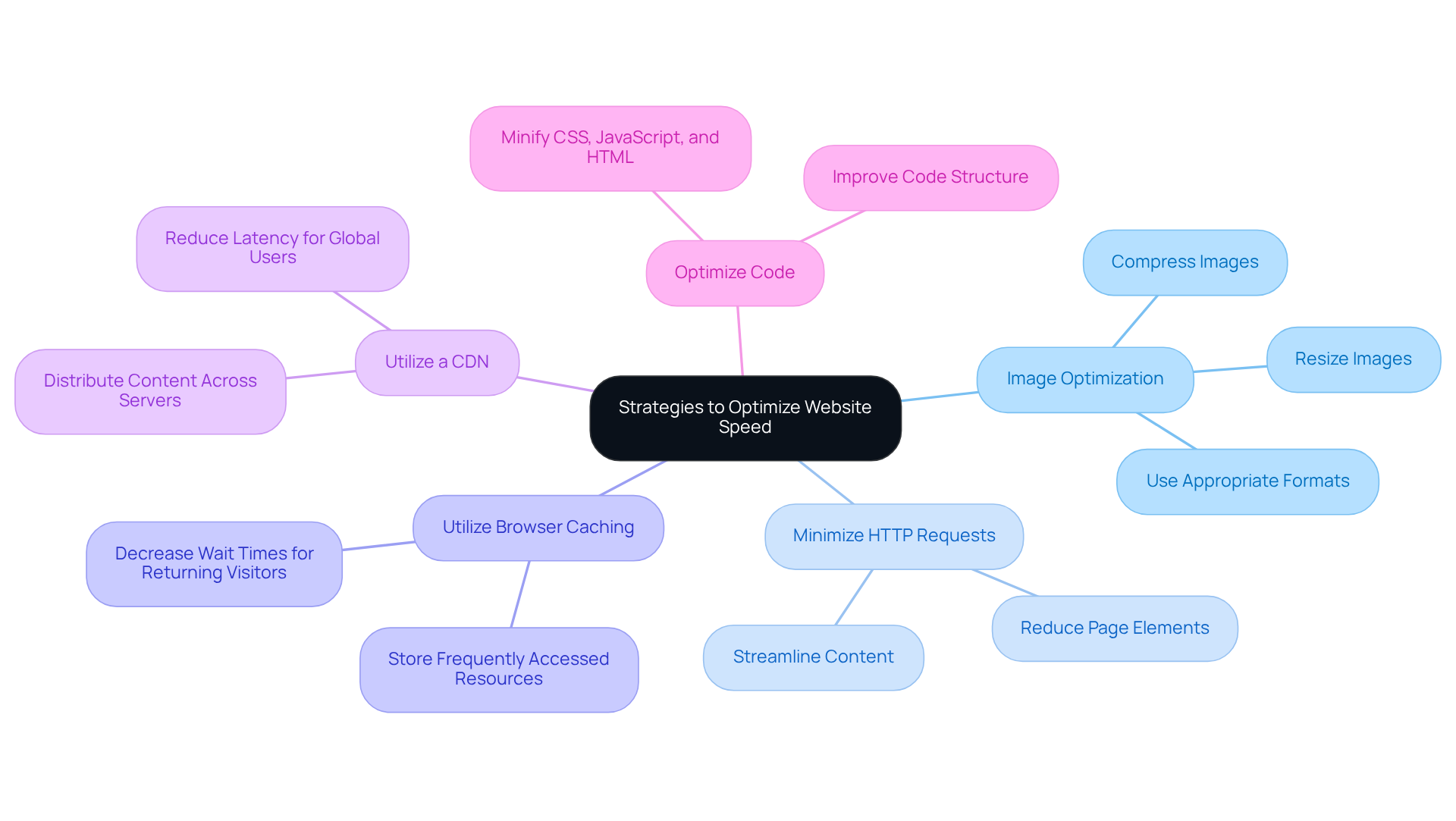
Overview
The speed of a website is paramount for the success of direct-to-consumer (DTC) brands. A mere one-second delay can result in a substantial decline in conversion rates and customer loyalty. Improving website speed not only elevates user experience and engagement but also has a positive effect on SEO rankings. This, in turn, drives higher sales and bolsters brand reputation. In today’s competitive landscape, prioritizing website performance is not just advantageous; it is essential for sustaining growth and ensuring customer satisfaction.
Introduction
The performance of a website transcends mere technical consideration; it stands as a pivotal factor in the success of direct-to-consumer (DTC) brands. In an era where consumers demand instant access to information, the speed at which a webpage loads significantly influences not only conversion rates but also customer loyalty and brand reputation. As businesses navigate the complexities of retaining customers in a fiercely competitive digital marketplace, a critical question emerges: how can DTC brands effectively optimize their website speed to enhance user experience and drive sales?
Understand Website Speed and Its Importance for DTC Brands
The speed of website performance—the time it takes for a webpage to fully load and become interactive—is a critical metric for direct-to-consumer (DTC) companies. This dimension of user experience profoundly impacts overall business outcomes. Research reveals that even a mere one-second delay can result in a 7% decrease in conversions, underscoring the pressing need for DTC companies to prioritize site speed within their growth strategies.
In today’s fast-paced digital landscape, consumers expect immediate access to information; a sluggish platform can frustrate potential customers by decreasing the speed of the website, leading to lost sales and weakened brand loyalty. Moreover, studies show that for every additional second a page takes to load, the speed of the website can lead to a significant decline in conversion rates. For instance, pages that load in 2.4 seconds achieve a conversion rate of 1.9%, while those that take 5.7 seconds see a dramatic drop to just 0.6%.
Additionally, 67% of participants reported abandoning a shopping cart due to the slow speed of the website, and 73% of online users encountered slow-loading pages on mobile devices in the past year. This stark contrast illustrates that is not merely a technical improvement but a crucial investment in profitability and customer loyalty for DTC companies aiming to thrive without escalating advertising expenses.
As noted by Unbounce, '82% of consumers claim that the speed of website loading times influences their purchasing decisions,' further highlighting the urgency of this issue. Furthermore, 42% of customers perceive a sluggish online platform as either certainly or potentially untrustworthy, which can severely damage a brand's reputation. Given these statistics, DTC companies must recognize that site performance transcends mere efficiency; it is vital to their overall success.
Case studies from Parah Group effectively illustrate this point. For example, a $30M clothing brand experienced a 35% increase in conversion rates after implementing strategies focused on improving their site’s loading time and reducing unnecessary pop-ups. Similarly, a cleaning product company boosted their average order value by 80% through enhancements aimed at user experience, including site performance and gamifying the progress bar for free shipping thresholds. These transformative outcomes emphasize the importance of prioritizing online performance as a fundamental aspect of conversion rate optimization strategies for DTC brands.

Explore How Website Speed Affects User Experience and Engagement
The is paramount in shaping user experience (UX) and serves as a fundamental aspect of Conversion Rate Optimization (CRO). A fast-loading platform not only improves the speed of website performance but also creates a positive impression, encouraging users to delve deeper into the content and engage more fully. Conversely, a slow speed of website loading can lead to significant frustration, drastically increasing bounce rates.
Research indicates that:
- 53% of visitors will abandon a site if the speed of the website takes longer than three seconds to load.
- 40% of users exit platforms that exceed this threshold.
This abandonment not only affects immediate sales but also jeopardizes long-term customer relationships. For DTC companies, delivering a seamless user experience is essential; it fosters trust and encourages repeat visits. Furthermore, 74% of U.S. mobile users abandon online pages that take over five seconds to load, underscoring the critical need for an improved speed of website performance.
By prioritizing the optimization of loading times, brands can enhance the speed of website performance, elevate user satisfaction, boost engagement levels, and ultimately drive higher conversion rates. As emphasized by Parah Group, an ongoing CRO program facilitates data-driven decisions that directly contribute to business growth, while simultaneously reducing customer acquisition costs and enhancing profitability.
Parah Group's distinctive strategy combines rigorous testing with a deep understanding of user behavior to ensure effective optimization of the speed of website. As Mor Mester asserts, "In 2025, a fast website isn’t just an advantage—it’s a necessity." In today's digital landscape, where 68.2% of web traffic originates from mobile devices, ensuring the speed of website load times is not merely advantageous—it is critical for success.

Analyze the Impact of Website Speed on SEO and Search Rankings
The speed of the website is a pivotal element in , directly influencing a site's visibility and efficiency. Google has verified that the speed of the website is a ranking criterion, indicating that sites with quicker loading times are more prone to achieve elevated positions in search results. This is particularly crucial for DTC companies that rely on organic traffic to generate sales. A slow-loading online platform can lead to increased bounce rates, which negatively impacts the speed of the website and SEO rankings. Indeed, studies show that 53% of visitors leave a site if the speed of the website takes longer than three seconds to load, highlighting the necessity for companies to enhance their performance.
Moreover, the speed of the website enhances user engagement metrics, such as time spent on the site and pages viewed per session, which are critical for improving overall SEO performance. By emphasizing online performance, DTC companies can not only enhance their presence in search engines but also draw more visitors and ultimately raise conversion rates. The relationship between the speed of the website and user satisfaction is evident: quick online platforms cultivate trust and minimize friction, enabling user actions such as purchases or registrations. As Google keeps enhancing its algorithms, ensuring the speed of the website will remain crucial for DTC companies seeking to succeed in a competitive digital environment.

Implement Strategies to Optimize Website Speed for Enhanced Performance
To enhance website speed, DTC brands can adopt several effective strategies that are essential for maintaining competitive advantage:
- Image Optimization: Compressing images is critical to minimizing file size without compromising quality. Large images can significantly decrease the speed of website loading times. Techniques such as resizing and utilizing appropriate formats can lead to quicker page performance.
- Minimize HTTP Requests: Reducing the number of elements on a page, including scripts and images, is vital for shortening response times. Each additional request contributes to overall loading time, making it imperative to streamline content to improve the speed of the website.
- Utilize Browser Caching: Activating caching allows frequently accessed resources to be retained, greatly decreasing wait times for returning visitors. This practice enables users to access pages more swiftly, thereby enhancing the speed of website on subsequent visits.
- Utilize a Content Delivery Network (CDN): Distributing content across multiple servers enhances access efficiency for users in various geographical areas. A CDN can effectively reduce latency and improve the speed of website load times, particularly for global audiences.
- Optimize Code: Minifying CSS, JavaScript, and HTML streamlines the code and enhances loading speed. Well-structured and optimized code results in an and smoother functionality.
By implementing these strategies, DTC companies can achieve significant improvements in online performance, which contributes to the speed of website, enhances user experiences, elevates SEO rankings, and increases conversion rates. For instance, brands that optimize their images have reported notable reductions in loading times, directly correlating with improved customer retention and engagement.
Moreover, statistics reveal that 47% of consumers expect the speed of a website to be 2 seconds or less, while 40% would abandon a site if the speed of the website exceeds 3 seconds to display. Additionally, for every second delay in the speed of the website, mobile page performance can cause conversions to decline by as much as 20%. Google emphasizes that the speed of website should be under three seconds for it to open, underscoring the importance of adhering to industry standards. A case study of Apexure illustrates their commitment to creating landing pages that load in under one second, showcasing the successful implementation of these strategies.

Conclusion
Website speed is paramount for the success of direct-to-consumer (DTC) brands. Fast-loading websites not only enhance user experience but also directly influence conversion rates and customer loyalty. In today's digital landscape, where instant access is a given, slow performance can frustrate users, leading to abandoned carts and lost sales.
Key insights reveal that even a one-second delay can drastically reduce conversions; in fact, 67% of users abandon their carts due to slow loading times. Moreover, faster websites enhance user engagement and boost search engine optimization, resulting in improved visibility in search results. Case studies demonstrate that brands prioritizing website speed experience significant increases in conversions and customer satisfaction.
To maintain a competitive edge, DTC companies must prioritize optimizing their website speed. Strategies such as:
- Image compression
- Minimizing HTTP requests
- Utilizing content delivery networks
can greatly enhance performance. As consumer expectations continue to rise, ensuring a fast-loading website is essential for growth and customer retention.
In conclusion, prioritizing website speed is vital for DTC brands striving for success in a competitive market. By adopting effective optimization techniques, brands can enhance user experiences, drive conversions, and secure long-term success.
Frequently Asked Questions
Why is website speed important for DTC brands?
Website speed is crucial for DTC brands because it significantly impacts user experience and business outcomes. A delay in loading time can lead to decreased conversions; even a one-second delay can result in a 7% decrease in conversions.
How does website speed affect conversion rates?
Conversion rates decline as page loading times increase. For example, pages loading in 2.4 seconds achieve a conversion rate of 1.9%, while those taking 5.7 seconds drop to just 0.6%.
What percentage of consumers abandon shopping carts due to slow website speed?
67% of participants reported abandoning a shopping cart because of the slow speed of the website.
How do consumers perceive slow-loading websites?
42% of customers view a sluggish online platform as either certainly or potentially untrustworthy, which can negatively affect a brand's reputation.
What impact does website speed have on customer loyalty?
Slow website speed can frustrate potential customers, leading to lost sales and weakened brand loyalty. Improving site speed is essential for maintaining customer trust and satisfaction.
What statistics highlight the influence of website speed on purchasing decisions?
According to Unbounce, 82% of consumers claim that the speed of website loading times influences their purchasing decisions.
Can improving website speed lead to increased conversion rates?
Yes, case studies show that enhancing website speed can lead to significant increases in conversion rates. For instance, a clothing brand saw a 35% increase in conversions after improving their site’s loading time.
What are some strategies DTC brands can implement to improve site performance?
Strategies include optimizing loading times, reducing unnecessary pop-ups, enhancing user experience, and gamifying elements like progress bars for free shipping thresholds.
FAQs











